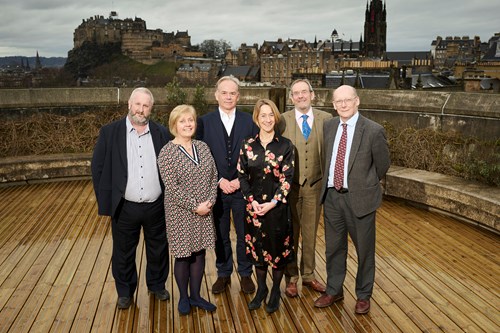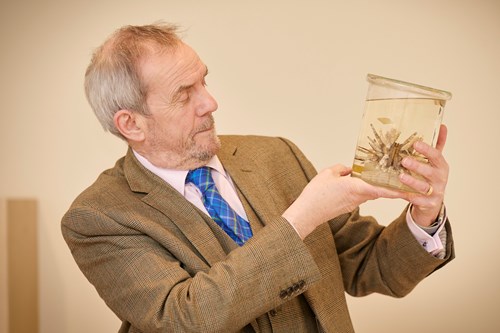SRUC Alliance for the Natural Economy Forum – Reflections #2

Jamie Newbold, Linda Hanna, Phil McLachlan, Susannah Bolton, Nick Owens and Charles Godfray pictured at the dinner
The second of the Alliance for the Natural Economy Forum dinners, convened by SRUC, was held on 28 March at the wonderful venue of the National Museum of Scotland in Edinburgh. This followed on from the success of our first forum in London last November, when we reflected on the nature of the natural economy and the role of natural capital and the elements of human, physical, social, institutional and knowledge capital that underpin society and well-being.
Professor Sir Charles Godfray, Director of the Oxford Martin School at the University of Oxford, opened with a presentation on the theme ‘Is consensus on land in Britain possible? ‘, starting with the ‘good news’ that Malthusian arguments could now be challenged and that because of the demographic transition population increase would plateau globally, probably this century, providing hope that humanity’s demands on the planet will cease to grow. These are the drivers that would affect land use and food consumption over the coming decades. He tells his students that he is more optimistic than when he was their age. However, as more people are brought out of poverty, demand for food requiring more resources to produce will increase. By mid-century we will need 30 – 60% more food. So, what should we do in the UK? Should we maintain production levels as the UK govt has suggested, intensify to produce more food or de-intensify to encourage nature. All three are legitimate outlooks. Perhaps, he suggests, we can balance all three objectives.
Prof Godfray went on to summarise what he identifies as the key drivers of and challenges for sustainable land use. These include how food and agriculture companies address their climate change commitments, where Scope 3 is a particular challenge, to the way in which global food systems had been tested by the war in Ukraine and the pandemic and been found quite resilient. Yet these tests, combined with the need to reform land use subsidy post-Brexit, pointed to a need for a really radical shift in land use policy, and equally as important to ensure a just transition where people are not deprived of their livelihoods. He introduced the Royal Society report on Multifunctional Landscapes and sketched some of the principles and analytics that might help better land-use decision-making,
He finished by lamenting that the notion of “Having one’s cake and eating it” had been sadly debased by certain recent political figures, but that with canny landscape decision making the nations of the UK might increase agricultural productivity and production, store carbon and increase biodiversity in the landscape, and maintain and increase land-based employment and livelihoods. The key is to look at the comparative advantage of different types of land to produce a spectrum of private and public goods. Though a continuum it can be helpful to think of three broad types of land use:
- Land chiefly managed for sustainable food production. It must be genuinely sustainable, and highly knowledge intensive (technology, plant and animal breeding, insights from agro-ecology). It would receive little or no public money, meaning investment can be repurposed.
- Land chiefly managed for multiple outputs. Accepting a reduction of yields to deliver public goods and therefore justifying the use of funding from the public purse. Again, highly knowledge intensive, with insights from the organic & regenerative movement particularly to the fore. A particular focus on farmland biodiversity.
- Land chiefly managed for non-food outputs, carbon storage, very high quality biodiversity sites (some rewilding in the sense of managed nature restoration). Again, highly knowledge intensive using insights, for example, from hydrology and landscape, restoration and ecosystem ecology.
Prof Godfray argued that in a small island all land must be highly productive, but we should take a broad view of productivity to include not just food and other marketable goods but also public goods such as biodiversity. And, he suggested, the realignment could be achieved without spending more but by reallocating CAP payments, and that it could be done in ways that produce jobs. To get there we will need a culture change among farmers, a clear land use framework and political leadership.
The discussion that followed covered the potential for a trade-off between increase in food prices and other public good benefits and how this could be implemented at an appropriate scale and granularity, without the need to create zones, but by careful implementation of incentives and penalties (polluter pays). The importance of technical innovation in the optimisation of all the land-use options was highlighted.

Professor Nick Owens holding a specimen from the Challenger Expedition which was made available by the museum
Professor Nick Owens, Director of the Scottish Association for Marine Science used a number of objects from the National Museum’s collection on the Challenger Expedition (1872-76) to frame a discussion on the foundations of marine science. He related the history of the voyage, and how it was led by academics from Edinburgh University, including Charles Wyville Thomson, who persuaded the Royal Society of London to ask the British Government provide H.M.S. Challenger for the voyage.
This, he highlighted, was an early example of researchers collaborating not just between institutions, but also with government in the pursuit of knowledge and innovation. He also noted that while the voyage was a peaceful one, with ship guns removed to accommodate scientific equipment, it nonetheless had commercial objectives in the way that shipping routes were explored to be of benefit to companies trading in the British Empire. This was an example of how the gathering of knowledge through intensive research could reap commercial dividends, albeit indirectly.
Prof Owens noted that after the expedition had returned to Britain the scientific findings of those on board were examined by over 100 scientists, primarily under the guidance of his personal hero John Murray. This would result in the greatest legacy of the cruise, The Report of the Scientific Results of the Exploring Voyage of H.M.S. Challenger during the years 1873-76, published between 1885 and 1895 over some 50 volumes. Nick showed the room an original copy of one of those volumes and described how they helped transform scientific understanding of the marine environment for years to come.
The legacy of the expedition is felt today, not just in the continued work of marine science institutions like SAMS, but also in the acceptance of methodologies and modes of collaboration between researchers both in the UK and internationally.
Phil McLachlan, Co-Founder and CEO of satellite data analytics business, D-CAT said he spoke from the perspective of a technologist and not as an expert in nature or the environment, but went on to discuss how technology was transforming our capacity to monitor and understand the impact of change in land use.
He explained that his satellite analytics business, D-CAT, was a result of an appreciation of the potential that could be harnessed through the commercialisation of sensor technology previously used by the military but now widely available, coupled with the potential of cloud based data processing. Those sensors could give a highly granular view of natural processes over time. Having initially tried to build applications using this data for farmers in Australia with limited success owing to the wrong product/market fit, it became clear that D-CAT’s core role was to help others understand their data, providing the potential for D-CAT’s platform to be integrated into customers’ applications.
Phil spoke about the potential that his business and others like it have to make a difference at significant scale by engineering solutions that offer best value. He stressed that he favoured the ‘Woolworths approach, not the Roll Royce approach’ if it achieved the best results, particularly because the latter does not in many cases scale up because of affordability.
Key to this was getting access to data that has been appropriately analysed and combined with simple ground based measures to create truly reliable and trustworthy monitoring services that are fit for purpose. As a case in point Phil suggested that “sticking a pole in the ground in peatland to mark which depth it gets rusty” is the type of useful, practical data point that can inform and reinforce the work they do on the quality of peatland restoration projects.
The point is, he argued, the task of monitoring natural capital restoration needs data that is reliable and trusted. If those data are lacking, either because the research isn’t there, or standards of data collection aren’t high enough, then market confidence in green finance vehicles won’t be sustained. The implication is that for this to happen, companies like D-CAT need to keep collaborating with research institutions to refine methodologies at sufficient scale.
This informed further discussion in the room about how institutions understand, measure and value natural capital, leading to questions about the need for agreed norms and best practice in governance to be established. Leaving new markets unregulated would be to undermine long term confidence in green finance initiatives, in turn undermining capacity to attract significant inward investment in natural capital. Moreover, we need to ensure that local communities aren’t by-passed by such schemes happening in their vicinity and ensure that wealth is both created and retained within those communities. This requires the development of mechanisms to drive innovation that are integrative, inclusive and interdisciplinary, building a narrative that promotes social and ecological identity within a place-based agenda.
There is a need and urgency for a focus on evidence-based standards that need to be developed by independent honest brokers. Getting this right requires institutional capital and deep collaboration to work at pace. The so-called ‘Green Triple Helix’ between academic researchers, government and businesses must work hard to establish these norms to bring about a truly just transition to a thriving natural economy.
Posted by Peter Smyth and Susannah Bolton on 05/04/2023
